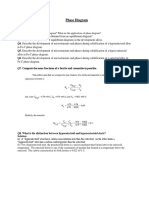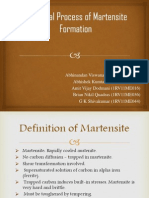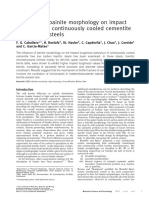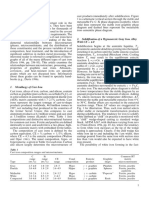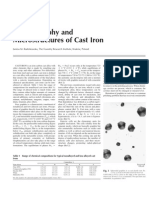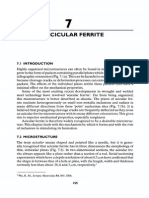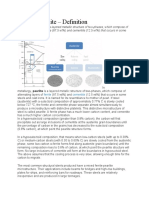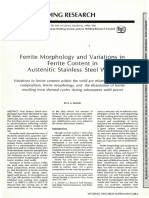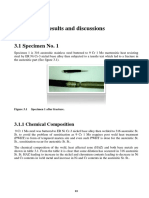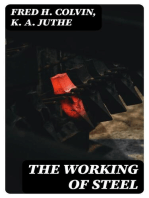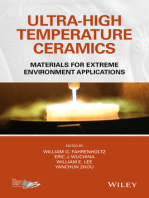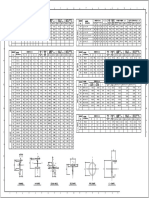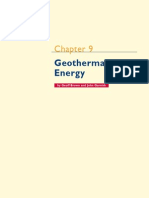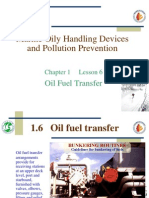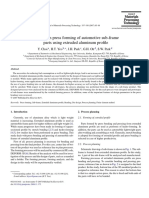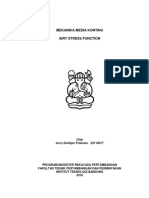Microestructura DeFZ y Grain Growth
Microestructura DeFZ y Grain Growth
Uploaded by
nerioalfonsoOriginal Description:
Copyright
Available Formats
Share this document
Did you find this document useful?
Is this content inappropriate?
Report this DocumentCopyright:
Available Formats
Microestructura DeFZ y Grain Growth
Microestructura DeFZ y Grain Growth
Uploaded by
nerioalfonsoCopyright:
Available Formats
Weld Metal Microstructure in Low Alloy Steels
3.1 Introduction
The weld metal microstructure is formed under highly nonequilibrium
conditions and differ distinctly from those experienced during casting,
thermomechanical processing, and heat treatment. For low alloy steels, the weld
microstructure evolution starts from the solidification with epitaxial growth of columnar
delta-ferrite () from the hot grain-structure of the parent plate at the fusion surface.
,!
The final weld metal microstructure is determined by the combination of alloy chemical
composition and the cooling rates experienced.
3.1.1 Classification of Weld Metal Microstructure
"alculation of microstructure needs a detailed description of each phase. For a
meaningful classification of the different features in a microstructure, the various phases
and microconstituents should be identified by using a system of nomenclature that is
both widely accepted and well understood. #n wrought steels, this need has been
satisfied to a large degree by the $ube scheme,
%
in which various ferrites are classified
according to their morphologies. Four well defined ferrite morphologies recogni&ed by
$ube
%
and
later extended by 'aronson
(
are) grain boundary allotriomorphs,
*idmansttaten side plates or laths, intragranular idiomorphs, and intragranular plates.
the ma+or components in the weld metal of low alloy steels include
allotriomorphic ferrite (), *idmanstatten ferrite (
w
), and acicular ferrite(
a
). There
may also some microphases composed of martensite (,), retained austensite (,) or
degenerate pearlite (-). #t can be noted that this classification of ferrite is consistent with
the morphological classification proposed by $ube,
%
although the notations are
somewhat different. 'cicular ferrite does not figure in the $ube scheme because it is
rarely observed in wrought steels. Fig. ../ shows the typical morphologies of the ma+or
microstructural components in the weld metal as well as typical phases in the 0'1 of
low alloy steels.
/./ 'llotriomorphic Ferrite ( )
2'llotriomorphic3 means a 2particle of a phase that does not have a regular
external shape3. 'llotriomorphic ferrite is the first phase to form on cooling austenite
below the 'e
.
temperature. #t nucleates at the columnar austenite grain boundaries and
then thic4en at a rate controlled by the diffusion of carbon in the austenite ahead of the
transformation interface.
/-5
The grain boundary allotriomorphs have curved
boundaries with the austenite. They are usually equi-axed or lenticular in form. #t is
generally accepted that the presence of substantial quantities of allotriomorphic ferrite
can result in poor toughness in low alloy steel weld deposits, because the relatively
large grains of offer little resistance to cleavage crac4 propagation.
/-6
/.6 *idmanstatten Ferrite (
w
)
7econdary *idmanstatten ferrite nucleates at the allotriomorphic
ferrite8austenite boundaries and grow as sets of parallel plates separated by thin regions
of austenite, the latter subsequently being retained to ambient temperature or
transforming to martentiste and8or pearlite. This *idmanstatten ferrite and its associated
microphases are sometimes referred as 2Ferrite with aligned 9artensite-'ustenite
carbide3,
//
which is the abbrevation referring to martensite, austenite, and carbides.
-rimary *idmansatten ferrite can nucleate directly from austenite boundaries and is not
covered by allotriomorphic ferrite, although its mechanism is identical to that of
secondary *idmanstatten ferrite.
/-.
/.. 'cicular Ferrite (
a
)
'cicular ferrite is a phase most commonly observed in low alloy steel weld deposits.
The term 2acicular3 means shaped and pointed li4e a needle. #t is now generally
recogni&ed that the acicular ferrites are thin, lenticular plates with three dimensional
morphology. 'lthough many efforts have been made in recent years, as shown in the
review papers,
/6-/5
the transformation mechanism of acicular ferrite is still uncertain.
0owever, it has been generally recogni&ed that acicular ferrite nucleates intragranularly
at inclusions within the large austenite grains. The presence of acicular ferrite can
significantly improve the toughness of the weld deposits because of its chaotic
microstructure, which deflects the propagation of cleavage crac4s.
/-.
/.5 9icrophases
9icrophases in this content means the transformation structures resulting from
carbon enriched retained austenite in low alloy steels. #t might include martensite,
retained austenite, bainite or degenerate pearlite.
(a) (b)
Fig) 5./ (a)) 9a+or microstructural components in the weld metal of low alloy steels: The
term ;F, *F, 'F, and -F refer to grain boundary ferrite (allotriomorphic ferrite),
*idmansatten ferrite, acicular ferrite (intragranular plates), and polygonal ferrite
(idiomorphic ferrite), respectively. (b)) 9a+or microstructural components in the 0'1 of
low alloy steels: The term <=, >=, and 9 refer to upper banite, lower banite, and
martensite, respectively.
/?
3.3 Microstructural Evolution In The Weld Metal
The microstructural evolution in the weld metal of low alloy steel is
schematically shown in Fig. 6 (adapted from =hadeshia
.5
). The final weld metal
microstructure is dominantly determined by the austenite decomposition process within
the temperature range %?? - @?? ". $uring cooling of the weld metal, allotriomorphic
ferrite is the first phase to form from the decomposition of austenite in low alloy steels.
#t nucleates at the austenite grain boundaries and grows by a diffusional mechanism.
's the temperature decreases, diffusion becomes sluggish and displacive
transformation is 4inetically favored. 't relatively low undercoolings, plates of
*idmanstatten ferrite forms by a displacive mechanism. 't further undercoolings,
bainite nucleates by the same mechanism as *idmanstatten ferrite and grows in the
form of sheaves of small platelets. 'cicular ferrite nucleates intragranularly at
inclusions and is assumed to grow by the same mechanism as bainite in the present
model.
/-., @
The morphology of acicular ferrite differs from that of conventional bainite
because the former nucleates intragranularly at inclusions and within large austenite
grains, while the latter nucleates initially at austenite grain boundaries and grows by the
repeated formation of subunits to generate the classical sheaf morphology.
0.1 1 10 100
Time (s)
0
400
800
1200
1600
T
e
m
p
e
r
a
t
u
r
e
(
o
C
)
+
+
(a) (b)
(c)
(d)
(e)
(f)
Ms
Liquid
Cooling
curve
Fig.6) 7chematic of microstructure evolution in the weld metal of low alloy steels. (a)
inclusion formation: (b) liquid metal solidification to ferrite: (c) single austenite
region: (d) allotriomorphic ferrite: (e) *idmanstatten side plate: (f) acicular ferrite8
bainite. (adapted from 0. A. $. 0. =hadeshia
.5
)
rain rowth
'ssuming that grain growth is diffusion controlled, driven by grain boundary
energy, and requires no nucleation, then the extent of transformation depends on the
integrated number of diffusive +umps during the weld thermal cycle. The austenite
grain growth in the 0'1 can be calculated by a 4inetic equation as)
g g 4 e dt
B
CT t 6
?
6
/
?
'
( )
(../)
where g is the grain si&e after time t, g
?
is the initial grain si&e, 4
/
is a 4inetic constant, B
is the activation energy for grain growth, T(t) is the temperature varying with time, and
C is the gas constant. The term in the brac4et of equation (/) is called the 24inetic
strength3 of the cycle, the extent of which reflects the total number of diffusive +umps
which ta4e place during the cycle. The quantity of 24inetic strength3 is shown as the
shadow area in Fig. 6. =ased on the concept of 24inetic strength3, the grain growth
equation can be simplified as)
P
RT
Q
e k g g
/
6
?
6
(..6)
where is a characteristic time constant for the thermal cycle, T
p
is the pea4
temperature of the thermal cycle, is a variable determined by B and T
p
and expressed
as)
/
Q
RT
P
(for thic4 plate) (..../)
6
CT
B
-
(for thin plate)
(....6)
The 4inetic constant 4
/
in equations (../) and (..6), which contains uncertain
4inetic factors, can be eliminated by using experimental data. <nder a specified
experimental condition, the grain si&e at a point of the 0'1 can be expressed as)
g g 4 e
B
CT
p D
D D
D
6
?
6
/
(..5)
where g
D
is the measured grain si&e produced by a thermal cycle characteri&ed by a pea4
temperature T
p
D
and a characteristic time constant
D
. "ombining equations (..6) and
(..5), the grain si&e for a specified weld thermal cycle can be calculated by the
following equation)
1
1
]
1
P P
T T R
Q
e
g g
g g
/ /
D D 6
?
6 D
6
?
6
D
(..@)
Equation (..@) establishes a relationship between grain si&e g and the thermal
cycle characteri&ed by variables T
p
and , which allows grain si&e in the 0'1 to be
drawn in a T
p
and space.
3.!.1.! "reci#itate dissolution and coarsening
3.!.1.!.A "reci#itate dissolution
$epending on the pea4 temperature and duration of the thermal cycle, carbides
and nitrides in the 0'1 of low alloy steels may dissolve or coarsen. #n this algorithm,
the precipitate particles are assumed roughly spherical and each precipitate is assumed
to be associated with a volume of surrounding matrix of radius l. The volume fraction
available for dissolution considering impingement of the diffusion fields in the
algorithm is calculated by Fohnson and 9ehl
66
and 'vrami
6.
type equation)
( )
f e
$t
l
'
. 6
.
8
(..)
where f is the volume fraction available for dissolution, t is the time, and $ is the
diffusion coefficient of the element of the precipitate which diffuses most slowly.
7tarting from equation (..), the dissolution of the precipitates during a weld thermal
cycle can be calculated based on the concept of 24inetic strength3 as described in the
above section. The volume fraction available for the dissolution of a precipitate during a
weld thermal cycle in the algorithm is derived and expressed as)
f e
B
C T T
- -
_
,
'
/
6
/ /
. 6
D D D
exp
8
(..!)
where B
6
is the activation energy for diffusion of the atoms of the precipitate which
diffuse most slowly, is a characteristic time constant for the thermal cycle, is a
variable determined by B
6
and T
p
(the pea4 temperature of the thermal cycle) in the
same relation as that described in equations (..../) and (....6),
and
are the values
of and corresponding to the complete dissolution at a temperature T
-
D
.
3.!.1.!.$ "reci#itate coarsening
For precipitates remain undissolved, they will coarsen during the subsequent
cooling procedure. The change of the precipitate radius (p-p
?
) can be related with
coarsening time t at a constant temperature T by the standard equation)
65,6@
- -
4 t
T
e
B
CT
. . 6
?
.
(..%)
where p is the radius of precipitate at time t, p
?
is the initial radius of the precipitate, 4
6
contains constants which depends on matrix composition, and B
.
is the activation
energy for diffusion between precipitates. #ntegrating equation (..%) over the thermal
cycle and using the method of section 6././, the radius of the precipitate can be related
with its cycle characteri&ed by a and t as following)
p p
p p
T
T
e
-
-
B
C T T
-
-
.
?
.
.
?
.
/ /
.
1
]
1
1
D D D
D
D
(..()
where is a variable determined by B
.
and T
p
(the pea4 temperature of the thermal
cycle) in the same relation as that described in equations (..../) and (....6), p
D
is the
average precipitate radius, which is produced by a thermal cycle characteri&ed by a
thermal variables T
p
D
and
D
.
3.!.1.3 Calculation of #hase volu%e fractions
The volume fractions of the various phases (ferrite8pearlite, bainite, and
martensite) are determined by the time necessary cooling from %?? to @??
o
" (t) and
the carbon equivalent of the steel ("
eq
). #n this algorithm, the volume fractions of
various phases are related with t based on the data of #naga4i and 7e4iguchi
6
who
established continuous cooling transformation (""T) diagrams for a wide range of
structural steels. Two specific cooling times are ta4en in the algorithm to give a @?G
martensite8@?G bainite structure, t
/86
m
, and a @?G bainite8@?G ferrite or pearlite
structure, t
/86
b
, as shown in Fig. .. The influence of the alloying elements on these
critical cooling times can be related to the carbon equivalent of the steel ("
eq
) by
empirical equations such as that recommended by the #nternational #nstitute of
*elding)
6!
" "
9n "r 9o H "u Ii
eq
+ +
+ +
+
+
G
G G G G G G
@ /@
(../?)
Then the critical cooling times are calculated as by the following equations)
6
log . .
8
t C
m
eq / 6
% !( /@6
(..//./)
log . .
8
t "
b
eq / 6
%%5 ? !5
(..//.6)
where t
has units of seconds and "
eq
is measured in weight percent.
The Fohnson-9ehl equation
66
is used to calculate the volume fractions of various
phases. #n their algorithm, the volume fraction of ferrite and pearlite are not
distinguished and expressed by the same equation)
H e
fp
t
t
n
_
,
'
/
? (
/ 6
.
8
(../6./)
where H
fp
is the volume fraction of ferrite8pearlite after a time t (characteri&ing the
cooling part of the weld thermal cycle), t
/86
is the time required for half the
transformation to occur, n is a value depending on the nucleation sites (it ta4es the
value . for random nucleation, 6 for nucleation on grain edges, and / for nucleation on
grain corners). The volume fractions of bainite and martensite formed from the
untranformed austenite during subsequent cooling can calculated and expressed as)
H e
m
t
t
m
_
,
'
? (
/ 6
6
.
8
(../6.6)
H e H
b
t
t
m
b
_
,
'
? (
/ 6
6
.
8
(../6..)
where H
b
and H
m
are the volume fractions of bainite and martensite, respectively.
The effect of prior austenite grain si&e on the transformation 4inetics are
considered in the algorithm by modifying the critical transformation times t
/86,
t
/86
b
and t
/86
m
. 'ssuming that the transformation time for a given grain si&e g
?
is t
/86
?
, it is
easy to understand that the volume fraction of ferrite8pearlite which forms within time
t for a different grain si&e g can be expressed by following equation (../.) as)
H e
fp
g t
g t
n
_
,
'
/
? (
?
/ 6
?
.
8
(../.)
This equation shows that as the grains grow, the amount of ferrite8pearlite which
can form during a given quench decreases, and the volume fractions of bainite and
martensite consequently increase. The equations for calculation of the volume fractions
of bainite and martensite can be similarly modified by considering effects of grain si&e
on the corresponding transformation times, t
/86
m
and t
/86
b
. The corrected
transformation times will be)
( ) t
g
g
t
m m
/ 6
?
/ 6
?
8 8
(../5./)
( ) t
g
g
t
b b
/ 6
?
/ 6
?
8 8
(../5.6)
where (t
/86
m
)
?
and (t
/86
b
)
?
are the transformation times for martensite and bainite at
given grain si&e g
?
.
3.!.1.& Co%%ents on the algorith%
The advantage of the algorithm is that microstructural diagrams can be
established, from which the austenite grain si&e, the extent of the dissolution of the
precipitates, and the amount of martensite in the 0'1 can be directly read. Two types of
0'1 microstructural diagrams can be developed by using the methods described above.
Jne is based on axes of log heat input and pea4 temperature, as shown in Fig. ..5(a),
and the other on both linear and logarithmic scales of heat input and distance below the
center line of the weld, as shown in Fig. ..5(b). The former is useful for obtaining an
overall picture of the effect of various welding processes on microstructure: the latter
provides a more physical picture of an actual weld. The results have been correlated
with actual welding experiments.
0owever, as ac4nowledged by the authors themselves, the least certain part of
the procedure is the calculation of the volume fractions of microstructural constituents.
Iot only the differences between some competitive products such as ferrite8pearlite are
not separated, but also ferrites formed by different phase transformation mechanisms
such as allotriomorphic and *idmanstatten ferrites are not distinguished. #n addition,
the transformation rates for ferrite8pearlite, bainite, and martensite are approximated by
using empirical formula based on the carbon equivalent index, which is somewhat
crude.
!.!. Algorith%s 'y (ir)aldy and Watt
1*+1,
' computer algorithm originally developed by Air4aldy et al.
/(-6/
for predicting
the hardenability of low alloy steels was adapted by *att et al.
/!,/%
to calculate the
microstructural development in the 0'1. This algorithm simulates the 4inetics of the
decomposition of austenite to its various daughter products. The required inputs for this
algorithm are the eutectoid temperature ('e
/
), the solidus temperature of the (+)/
phase boundary ('e
.
), the ferrite solubility temperature as a function of carbon (F7), the
bainite start temperature (=7), and the martensite start temperature (97). #n the
algorithm, these inputs are empirically calculated from the composition of the alloy as
equations (../@./)K(../@.@) and are listed in Table ../. The prior austenite grain si&e in
the 0'1 is calculated by the grain growth equations proposed by 'shby and
Easterling,
/@,/
as discussed section ..6././.
' set of equations were developed in this algorithm to model each of the
daughter products from austenite decomposition process. These equations assume that a
single continuous function can describe both nucleation and subsequent growth for each
of the daughter phases. The general reaction rate for each reaction can be expressed
as)
/!,/%
( ) ( )
dL
dt
= ; T L L
m p
, /
(../)
where L is the volume fraction of the daughter product, = is an effective rate coefficient
which depends on T, the temperature, and ;, the austenite grain si&e. The semi-
empirical coefficients, m and p, are set to less than one to assure convergence in a form
that is derived from a point nucleation and impingement growth model.
6%
The rate
coefficient includes the effect of grain si&e on the density of nucleation sites. #t also
includes the amount of austenite supercooling, and the effect of alloying elements and
temperature on diffusion. =ased on the general reaction rate equation, the reaction rates
for various products are determined by considering the corresponding phase
transformation characteristics. These reaction rate equations are expressed as equations
(../!./)K(../!..) in the algorithm and are listed in Table ..6.
#n the rate equations listed in Table 6, it is important to use the precise definition
of L. #f one simply defines L as the volume fraction of ferrite then it is possible to use
equation (/!./) alone to form more than the equilibrium amount of ferrite in the
intercritical temperature region. This and the relative change in the thermodynamics
driving force for the reaction are corrected in the algorithm by proposing a phantom
reaction which go to completion. The phantom reaction product is L
F
M LL
FE
where
L
FE
is the equilibrium fraction of ferrite given by the lever law at that temperature. Thus
in equation (/!./), L is set to be L M L
F
8L
FE
. #f some of the austenite has previously
transformed to ferrite at the onset of pearlite formation, then the amount of
untransformed austenite will be (/-L
FE
). 's the result, L is set to be L M L
p
8(/-L
FE
) in
equation (/!.6) for pearlite formation. #f pearlite exists before the bainite start
temperature is crossed, it is assumed that the existing pearlite-austenite interface
continues to transform, but now yielding to bainite. Thus L in equation (/!..) is
originally L
p
. #f no pearlite exists, then
Table ../) "alculation of the temperatures for various phase transformation.
'e/(") M !6. - /?.! 9n - /.( Ii N 6( 7i N /.( "r N 6(? 's N .5 * (../@./)
'e " " Ii 7i H 9o *
9n "r "u - 'l 's Ti
.
(/6 6?. /@6 55 ! /?5 ./@ /./
.? // 6? !?? 5?? /6? 5??
( ) . . . .
..................
+ + + +
+ + + +
(../@.6)
F7(") M (/6 - %5%" (../@..)
=7(") M @ - @%" - .@9n -!@7i - /@Ii - .5"r - 5/ 9o (../@.5)
97(") M @/ - 5!5" -..9n -/!Ii - /!"r - 6/ 9o (../@.@)
D The compositions in the table are in wtG.
Table ..6) Cate equations for formation of various phase products.
Ceaction Cate equation "omment
Ferrite
formation
dL
dt
T L L
"J9 CT)
; L L
6 /
6. ???
/ 6 . 6 / . 6 . ( )8 ( )8 8
( )
exp( , 8
(/!./)
T M 'e
.
- T:
"J9 M @(.G9n N
/.5@GIi N !.!G"r N
655G 9o
-earlite
formation
dL
dt
T $L L
"r 9o Ii
; L L
+ + +
6 /
/!( @56 5G
/ 6 . 6 / . 6 . ( )8 ( )8 8
( )
. . (G G G )
(/!.6)
T M 'e
/
- T:
$ is the effective
diffusion coefficient
for carbon modified
by considering the
presence of other
alloying elements.
=ainite
formation
dL
dt
T e L L)
" "r 9o f L, "
; CT L L
i
+ + +
6 /
6 .5 /?/G .%G /(G /?
/ 6 6 6! ??? 6 / . 6 .
5
( )8 , 8 ( )8 8
(
( . . . ) ( )
(/!..)
T M =7 - T:
f(L,"
i
) is a coefficient
determined by L and
the content of alloying
elements
D L is the existing daughter product volume fraction , dL8dt is the units of volume
fraction per second: ; is the '7T9 grain si&e number of austenite.
because the bainite reaction is sluggish, L is simply the fraction of bainite formed and it
continues to transform until the remaining austenite is consumed or the martensite start
temperature is reached.
The form of the austenite decomposition equations in this algorithm has its basis
in the theory of reaction 4inetics. The empirical factors used in the equations have been
accumulated over 6?? different steel compositions to produce a good fit to their TTT
and ""T diagrams. The algorithm has been combined with a finite element heat transfer
model to predict the 0'1 microstructure.
6(
The predicted microstructure was found
comparable with the experimental results. 0owever, li4e the algorithm developed by
Easterling et al., no distinguish has been made between allotriomorphic ferrite and
*idmanstatten ferrite in this algorithm. #n addition, the reaction 4inetic arguments on
which the algorithm are based are not universally accepted.
.?,./
#n particular, the
assumption that the nucleation and subsequent growth can be treated as a single
continuous function may not be valid.
6.. 9odel by =hadeshia and co-wor4ers
/-.
The two algorithms described above are only used for prediction of the
microstructural development in the 0'1. This is mainly because many of the empirical
constants in their algorithms were obtained by 2mechanically3 fitting the experimental
data (e.g. experimentally determined TTT and ""T diagrams) into the classical 4inetic
equations. These experimental TTT and ""T diagrams were normally established under
the condition that the chemical composition within the prior austenite is homogeneous.
Therefore, the algorithms stemming from using these data will not be suitable for
prediction of microstructural development in the weld metal, in which there exists
significant solute segregation in the prior austenite due to nonequilibrium solidification.
=ased on thermodynamics and phase transformation 4inetics, =hadeshia et al
/-.
developed a comprehensive model for the decomposition of austenite in the weld metal
of low alloy steels. #n this model, the phase transformation mechanisms for the various
microconstituents, the multicomponent phase diagram, and non-equilibrium cooling
conditions have been systematically considered in predicting the microstructural
development in the weld metal. The transformation start temperatures for a time-
temperature-transformation diagram in low alloy steel can be calculated from this
model. The volume fractions of various microstructural constituents are calculated
based on their corresponding phase transformation mechanisms. #n the present research,
the model developed by =hadeshia et al
.-5
will be coupled with the cooling rates from
our .$ heat transfer and fluid flow model to model the microstructural evolution in the
weld metal of low alloy steels.
/. 0. A. $. 0. =hadeshia and >. -E. 7vensson) in Mathematical Modeling of Weld
Phenomena, ed. by 0. "er+a4 and A.E. Easterling, p. /?(, #nstitute of 9aterials
(/((.).
.
6. 0. A. $. 0. =hadeshia) in ORecent Trends in Welding Science and Technology, ed.
by 7. '. $avid and F. 9. Hite4, p. /%(, '79 #ITECI'T#JI'>, 9aterials -ar4,
J0 (/((?).
.. 0. A. $. 0. =hadeshia, >. -E. 7vensson, and =. ;retoft) Acta metall., 33, /6!/
(/(%@).
5. 0. A. $. 0. =hadeshia) Progress in Materials Science, !-, .6/ (/(%@).
@. 0. A. $. 0. =hadeshia) ainite in Steels, #nstitute of 9aterials (/((6).
. *. F. 7avage, ". $. >undin, and '. 0. 'aronson) Weld. !., &&, /!@ (/(@).
!. ;. F. $avies and F. ;. ;arland) "nt. Metall#rgical Re$., !., %. (/(!@).
%. ". '. $ube, 0. #. 'aronson, and C. F. 9ehl) Re$. Met., //, 6?/ (/(@%).
(. 0. #. 'aronson) in %ecom&osition of A#stenite 'y %iff#sional Processes, ed. by H. F.
1ac4ay and 0. #. 'aronson, p. .%!, *iley, Iew Por4 (/(6).
/?. Jystein ;rong) Metall#rgical Modelling of Welding, p. xx, #nstitute of 9aterials
(/((5).
//. 9'"
/6. J. ;rong and $. A. 9atloc4) "nt. Met. Re$., 31, 6! (/(%).
/.. $. F. 'bson and C. F. -argeter) "nt. Met. Re$., 31, /5/ (/(%).
/5. 0. A. $. 0. =hadeshia) in Phase Transformation(), ed. by ;. *. >orrimer, p. .?(,
#nstitute of 9etals, >ondon (/(%%).
/@. 'shby and A. E. Easterling) Acta metall., 3., /(( (/(%6).
/. F. ". #on, A. E. Easterling, and 9. F. 'shby) Acta metall., 3!, /(5( (/(%5).
/!. $. F. *att, >. "oon, 9. =ibby, F. ;olda4, and ". 0enwood) Acta metall., 30, .?6(
(/(%%).
/%. >. "oon and $. F. *att) in Com&#ter Modeling of *a'rication Processes and
Constit#ti$e eha$io#r of Materials, ed. by F. Too, p. 5!, "'I9ET, Jttawa (/(%!).
/(. F. 7. Air4aldy and $. Henugopalan) in Phase Transformations in *erro#s Alloys, ed. by
'. C. 9arder and F. #. ;oldenstein, p. /6@, 'm. #nst. 9in. Engrs, -hiladephia, -'
(/(%5).
6?. F. 7. Air4aldy and C. ". 7harma) Scri&ta metall., 10, //(. (/(%6).
6/. F. 7. Air4aldy) Metall. Trans., &, 6.6! (/(!.).
66. *. '. Fohnson and C. F. 9ehl) Trans. Am. "nst. Min. +ngrs, 130, 5/ (/(.().
6.. 9. 'vrami) !. Chem Phys., -, /!! (/(5/).
65. #. 9. >ifshit& and H.H. 7lyo&ov) F. -hys. "hem.,1-, .@ (/(/).
6@. ". 9. *agner) 1. Electrochem., 0/, @%/(/(/).
6. 9. #naga4i and 0. 7e4iguchi) Trans. ,atn. Res. "nst. Metals, Fapan, !, /?6
(/(?).
6!. #nternational #nstitute of *elding $oc. ##78##*-.%6-!/, 2;uide to the
*eldability of "-9n 7teels and "-9n 9icroalloyed 7teels3 (/(!/).
6%. F. *. "ahn) Acta metall., &, @!6 (/(@).
6(. ". 0enwood, 9. =ibby, F. ;olda4, and $. F. *att) Acta metall., 30, .?6( (/(%%).
.?. 9. =. Auban, C. Fayaraman, E. =. 0awbolt, and F. A. =rimacombe) Metall. Trans.,
1*A, /5(. (/(%).
./. E. =. 0awbolt, =. "hau and F. A. =rimacombe) Metall. Trans., 1&A, /%?. (/(%.).
.6. A. ". Cussell) Acta metall., 10, !/ (/(%).
... A. ". Cussell) Acta metall., 1*, //6. (/(().
.5. 0. A. $. 0. =hadeshia) %oc#ment of -Weld Microstr#ct#re Program., $epartment of
9at. 7ci and 9etallurgy, <niversity of "ambridge, <A, unpublished.
.@. F. '. "alvo, A. -. =ently, and C. ;. =a4er/ St#dies of the Welding Metall#rgy of
Steels, p. !/, =*C', 'bingdon, "ambridge (/(.).
.. '. 0ultgern) !ernkontorets Ann, 130, 5?. (/(@/).
.!. 0. A. $. 0. =hadeshia) Metal Science, 10, /@( (/(%6).
.%. 9. "ohen) Trans. ASM, !,, @. (/(5?).
.(. F. *. "hristian) The Theory of Transformations in Metals and Alloys, Edition /,
p. 5(6, -ergamon, Jxford (/(@).
5?. E. 7cheil) Arch. +isenh#tten0esen, 1!, @@ (/(.@).
5/. 9. Ta4ahashi and 0. A. $. 0. =hadeshia) Materials Transactions, F#9, 3!, %( (/((/).
56. -. -. Aoistinen and C. E. 9arburger) Acta metall., *, @( (/(@().
5.. C. Trivedi) Metall. Trans., 1, (6/ (/(!?).
55. 0. $. A. 0. =hadeshia and >. -E. 7vensson) !. Materials Science, !&, ./%?
(/(%().
5@. A. 9undra, T. $ebCoy and A. Ael4ar) ,#merical 1eat Transfer, !-, //@ (/(().
5. >.-E. 7vensson, =. ;retoft and 0. A. $. 0. =hadeshia) Scand. !. Metall#rgy, 1/, (!
(/(%).
5!. >.-E. 7vensson, and =. ;retoft) Welding Research S#&&lement, 1!, 5@5 (/((?).
5%. 1. Pang and T. $ebCoy) Science and Technology of Welding and !oining, !, @. (/((!).
5(. J. ;rong) Metall#rgical Modelling of Welding, p. xx, #nstitute of 9aterials
(/((5).
@?. E. '. 9et&bower, ;. 7panos, C. *. Fonda, and C. '. Handermeer/ Science and
Technology of Welding and !oining, !, xx (/((!).
@/. F. *. "hristian and $. H. Edmonds) "nt. Conf. 2n Phase Transformations in
*erro#s Alloys, ed. by '. C. 9arder and F. #. ;oldenstein, p. 6(., 'm. #nst. 9in.
Engrs, -hiladephia, -' (/(%5).
@6. A. E. Easterling) in ORecent Trends in Welding Science and Technology, ed. by
7. '. $avid and F. 9. Hite4, p. /!!, '79 #ITECI'T#JI'>, 9aterials -ar4, J0
(/((?).
@.. 7. '. $avid and 7. 7. =abu) in OMathematical Modelling of Weld Phenomena,
ed. by 0. "er+a4 and 0. A. $. 0. =hadeshia, p. /?(, #nstitute of 9aterials (/((!).
You might also like
- Quiz 1 Machine DesignDocument5 pagesQuiz 1 Machine DesignUsama Tariq50% (2)
- Materials For LNG ServicesDocument10 pagesMaterials For LNG ServicesSung Hyun TakNo ratings yet
- Wind 28pgdDocument28 pagesWind 28pgdnerioalfonsoNo ratings yet
- 논문자료 - ASS 취화 - 오스테나이트SUS - EmbrittlementDocument17 pages논문자료 - ASS 취화 - 오스테나이트SUS - EmbrittlementforashNo ratings yet
- Sample Questions For Phase DiagramDocument5 pagesSample Questions For Phase DiagramMohaiminul Islam TalhaNo ratings yet
- Embrittlement_of_austenitic_stainless_stDocument8 pagesEmbrittlement_of_austenitic_stainless_stJoshi DhvanitNo ratings yet
- 3 Carbide Precipitation: 3.1 Upper BainiteDocument28 pages3 Carbide Precipitation: 3.1 Upper BainiteMarziana Mat DinNo ratings yet
- Research Papers On Grey Cast IronDocument4 pagesResearch Papers On Grey Cast Ironfealwtznd100% (1)
- Tarea 5 - Dominguez Castro RocíoDocument8 pagesTarea 5 - Dominguez Castro RocíoRoox DomínguezNo ratings yet
- The Mechanism of Acicular Ferrite in Weld DepositsDocument12 pagesThe Mechanism of Acicular Ferrite in Weld DepositsPedro CunhaNo ratings yet
- (B0638) Zhuyao Zhang, R. A. Farrar-Atlas of Continuous Cooling Transformation (CCT) Diagrams Applicable To Low Carbon Low Alloy Weld Metals (Matsci-Maney Materials Science (1995)Document101 pages(B0638) Zhuyao Zhang, R. A. Farrar-Atlas of Continuous Cooling Transformation (CCT) Diagrams Applicable To Low Carbon Low Alloy Weld Metals (Matsci-Maney Materials Science (1995)Jayanta MondalNo ratings yet
- Ffiffi: T (IlchDocument9 pagesFfiffi: T (Ilchzuzu_boy6No ratings yet
- Heat Treatment of 1045 Steel PDFDocument17 pagesHeat Treatment of 1045 Steel PDFH_DEBIANENo ratings yet
- TRIP SteelDocument6 pagesTRIP Steeldzb2022No ratings yet
- Evolution of Microstructural Banding During The Manufacturing Process of Dual Phase SteelsDocument3 pagesEvolution of Microstructural Banding During The Manufacturing Process of Dual Phase SteelsWazir Shah KazmiNo ratings yet
- The Iron-Carbon Phase DiagramDocument16 pagesThe Iron-Carbon Phase DiagramMeena SivasubramanianNo ratings yet
- Höganas-Handbook No.6-Metallography PDFDocument288 pagesHöganas-Handbook No.6-Metallography PDFnyilmaz72411100% (1)
- Cast Iron SolidificationDocument8 pagesCast Iron SolidificationMostafa OthmanNo ratings yet
- Heat TreatmentDocument4 pagesHeat Treatment정석원No ratings yet
- Industrial Process of Martensite FornationDocument23 pagesIndustrial Process of Martensite Fornationqnikil7_669442093No ratings yet
- Detecting Transformation From Delta Ferrite To Sigma Phase in SsDocument9 pagesDetecting Transformation From Delta Ferrite To Sigma Phase in SsAndrea CalderaNo ratings yet
- Heat Treatment: Dr. Santosh S. HosmaniDocument7 pagesHeat Treatment: Dr. Santosh S. Hosmaniprakush01975225403No ratings yet
- Influence of Bainite 01.2014Document8 pagesInfluence of Bainite 01.2014smith willNo ratings yet
- First Page PDFDocument1 pageFirst Page PDFPradyut TripathyNo ratings yet
- 374 376 PDFDocument3 pages374 376 PDFSinhrooNo ratings yet
- Heat TreatmentDocument179 pagesHeat TreatmentDebye101100% (1)
- Metallography and Microstructures of Cast Iron: Janina M. Radzikowska, The Foundry Research Institute, Krako W, PolandDocument24 pagesMetallography and Microstructures of Cast Iron: Janina M. Radzikowska, The Foundry Research Institute, Krako W, PolandmeteminNo ratings yet
- Materials Letters: Y.Y. Song, X.Y. Li, L.J. Rong, D.H. Ping, F.X. Yin, Y.Y. LiDocument4 pagesMaterials Letters: Y.Y. Song, X.Y. Li, L.J. Rong, D.H. Ping, F.X. Yin, Y.Y. LiGhazal NanaaNo ratings yet
- 1997-Free Ferrite in Pearlitic Ductile Iron - Morphology and Its Influence On Mechanical PropertiesDocument7 pages1997-Free Ferrite in Pearlitic Ductile Iron - Morphology and Its Influence On Mechanical PropertiesSelauco Vurobi JrNo ratings yet
- Welding of Austenitic Stainless Steel - Job Knowledge 103Document2 pagesWelding of Austenitic Stainless Steel - Job Knowledge 103chowhkNo ratings yet
- Cast IronsDocument9 pagesCast IronsSatria Adi NugrohoNo ratings yet
- Modification of Fe-Cr-C Alloys Using Mischmetal PDFDocument3 pagesModification of Fe-Cr-C Alloys Using Mischmetal PDFFàtí ĐCNo ratings yet
- Bhadeshia 2006Document11 pagesBhadeshia 2006prabuNo ratings yet
- Effect of Calcium and Magnesium Treatment On Steel WeldabilityDocument7 pagesEffect of Calcium and Magnesium Treatment On Steel WeldabilitySuleyman HaliciogluNo ratings yet
- Solidification Cracking in SS Welds Pe1119Document24 pagesSolidification Cracking in SS Welds Pe1119Claudia Mms100% (1)
- Austenite: Iron-carbon phase diagram, showing the conditions under which austenite (γ) is stable in carbon steelDocument4 pagesAustenite: Iron-carbon phase diagram, showing the conditions under which austenite (γ) is stable in carbon steelVysakh VasudevanNo ratings yet
- Tempering ReviewDocument34 pagesTempering ReviewAleš Nagode100% (1)
- Dataset We UsedDocument11 pagesDataset We UsedDev Raj SoniNo ratings yet
- EXP8 JominyDocument6 pagesEXP8 JominyDrShashikant DargarNo ratings yet
- 1 - Heat TreatmentDocument61 pages1 - Heat TreatmentMohamed El SayadNo ratings yet
- Iron-Carbon DiagramDocument3 pagesIron-Carbon DiagramnaniNo ratings yet
- Improvement of Mechanical Properties in Structural Steels by Development of Acicular Ferrite MicrostructuresDocument2 pagesImprovement of Mechanical Properties in Structural Steels by Development of Acicular Ferrite MicrostructuresevfratNo ratings yet
- Transf Fases Na SoldagemDocument36 pagesTransf Fases Na SoldagemengetarcioNo ratings yet
- Choi ThesisDocument86 pagesChoi ThesisAlex CostaNo ratings yet
- What Is PearliteDocument4 pagesWhat Is Pearliteardy cornettoNo ratings yet
- Tugas Essay Cast IronDocument11 pagesTugas Essay Cast IronGalih SenopatiNo ratings yet
- How The Material Built For Special PurposeDocument43 pagesHow The Material Built For Special PurposeDidi SudiprayitnaNo ratings yet
- Future of Advanced High Strength SteelDocument7 pagesFuture of Advanced High Strength Steeldzb2022No ratings yet
- Iron - Carbon SystemDocument21 pagesIron - Carbon SystemYavana KeerthiNo ratings yet
- Cast IronsDocument8 pagesCast IronsAlberto LunaNo ratings yet
- Oxidation of Stainless Steels (AISI 304 and 316) at High Temperature. Influence On The Metallic SubstratumDocument9 pagesOxidation of Stainless Steels (AISI 304 and 316) at High Temperature. Influence On The Metallic SubstratumRedina AyuNo ratings yet
- 1 s2.0 S1359645405006701 MainDocument11 pages1 s2.0 S1359645405006701 MainVikram JainNo ratings yet
- Ferrite Morphology and Variations inDocument9 pagesFerrite Morphology and Variations inAndrea CalderaNo ratings yet
- Hardening From The Liquid StateDocument5 pagesHardening From The Liquid StateSinhrooNo ratings yet
- Chapter 3 EditedmmDocument25 pagesChapter 3 EditedmmYasser RezkNo ratings yet
- Industrial Process of Martensite FornationDocument16 pagesIndustrial Process of Martensite Fornationqnikil7_669442093No ratings yet
- Effect of Prior Austenite Grain Size On Pearlite Transformation in A Hypoeuctectoid Fe-C-Mn SteelDocument30 pagesEffect of Prior Austenite Grain Size On Pearlite Transformation in A Hypoeuctectoid Fe-C-Mn SteelAmit Ranjan KumarNo ratings yet
- Failures Induced by Abnormal Banding in Steels - D'errico2010Document7 pagesFailures Induced by Abnormal Banding in Steels - D'errico2010Angélica NogueiraNo ratings yet
- The Working of Steel: Annealing, Heat Treating and Hardening of Carbon and Alloy SteelFrom EverandThe Working of Steel: Annealing, Heat Treating and Hardening of Carbon and Alloy SteelNo ratings yet
- Ultra-High Temperature Ceramics: Materials for Extreme Environment ApplicationsFrom EverandUltra-High Temperature Ceramics: Materials for Extreme Environment ApplicationsWilliam G. FahrenholtzNo ratings yet
- PCR LateralDocument1 pagePCR LateralnerioalfonsoNo ratings yet
- Control ValveDocument12 pagesControl ValvenerioalfonsoNo ratings yet
- PCR SuperiorDocument1 pagePCR SuperiornerioalfonsoNo ratings yet
- 0001 000000Document1 page0001 000000nerioalfonsoNo ratings yet
- Pipe Rack DetailDocument12 pagesPipe Rack DetailnerioalfonsoNo ratings yet
- Aislamiento Hrizontal Y VerticalDocument2 pagesAislamiento Hrizontal Y VerticalnerioalfonsoNo ratings yet
- Emissivity TableDocument14 pagesEmissivity Tablenerioalfonso100% (1)
- Natural Gas EngineeringDocument106 pagesNatural Gas Engineeringnerioalfonso100% (1)
- Production PlatformDocument23 pagesProduction PlatformnerioalfonsoNo ratings yet
- T206 Book2 Chap9Document42 pagesT206 Book2 Chap9nerioalfonsoNo ratings yet
- L Coa: by Janet RamageDocument30 pagesL Coa: by Janet RamagenerioalfonsoNo ratings yet
- L Coa: by Janet RamageDocument30 pagesL Coa: by Janet RamagenerioalfonsoNo ratings yet
- Wind 27pgdDocument27 pagesWind 27pgdnerioalfonsoNo ratings yet
- A Survey of One of The Most Important Pressure Pipe CodesDocument3 pagesA Survey of One of The Most Important Pressure Pipe CodesnerioalfonsoNo ratings yet
- SECTION 02620 High Density Polyethylene (Hdpe) Pipe and FittingsDocument10 pagesSECTION 02620 High Density Polyethylene (Hdpe) Pipe and FittingsnerioalfonsoNo ratings yet
- Marine Oily Handling Devices and Pollution Prevention: Oil Fuel TransferDocument55 pagesMarine Oily Handling Devices and Pollution Prevention: Oil Fuel Transfernerioalfonso100% (1)
- PMP - Plantilla de RegistroDocument4 pagesPMP - Plantilla de RegistronerioalfonsoNo ratings yet
- 14.2.oil Tank FoundationDocument17 pages14.2.oil Tank Foundationnerioalfonso100% (2)
- Standard Test Method For Splitting Tensile Strength of Cylindrical Concrete Specimens1Document5 pagesStandard Test Method For Splitting Tensile Strength of Cylindrical Concrete Specimens1Lupita RamirezNo ratings yet
- 3638 PDFDocument9 pages3638 PDFSridhar TholasingamNo ratings yet
- A Study On Press Forming of Automotive Sub-Frame Parts Using Extruded Aluminum ProfileDocument4 pagesA Study On Press Forming of Automotive Sub-Frame Parts Using Extruded Aluminum ProfilerubencitomanrdpNo ratings yet
- Growth Mechanism of Phases by Interdiffusion and Diffusion of Species in The Niobium-Silicon SystemDocument9 pagesGrowth Mechanism of Phases by Interdiffusion and Diffusion of Species in The Niobium-Silicon SystemstefanyrsrNo ratings yet
- GFRP Rebars 3Document12 pagesGFRP Rebars 3Vandhana PVNo ratings yet
- 1304 2 CTR PDFDocument107 pages1304 2 CTR PDFAnirbanNo ratings yet
- Sheet Metal Forming Using Environmentally Benign LubricantDocument12 pagesSheet Metal Forming Using Environmentally Benign LubricantJuliano ErcolaniNo ratings yet
- Glossary of Casting TerminologyDocument12 pagesGlossary of Casting TerminologyNonameNo ratings yet
- Materials Science: Abhijit Chatterjee Jayesh BellareDocument19 pagesMaterials Science: Abhijit Chatterjee Jayesh BellareAbhishekNo ratings yet
- Solar Cells Energy Loss Is Problem For: Examples Where Phonons Are ImportantDocument51 pagesSolar Cells Energy Loss Is Problem For: Examples Where Phonons Are Importantjose mirandaNo ratings yet
- Bbn's Aircraft Structures 1 University QN 15Document38 pagesBbn's Aircraft Structures 1 University QN 15BIBIN CHIDAMBARANATHANNo ratings yet
- Mindlin 1936 PDFDocument9 pagesMindlin 1936 PDFsanjeev malhotraNo ratings yet
- Torsion Formal ReportDocument28 pagesTorsion Formal ReportEng RuiJun79% (24)
- Prestressed Concrete StructuresDocument44 pagesPrestressed Concrete StructuresOchini ChandrasenaNo ratings yet
- TEST 1 DAM14203 - Sem1 2021 - 19 NovDocument3 pagesTEST 1 DAM14203 - Sem1 2021 - 19 NovSsg AqifNo ratings yet
- Fiber Reinforced Polymer Composites: A ReviewDocument13 pagesFiber Reinforced Polymer Composites: A ReviewUGCJOURNAL PUBLICATIONNo ratings yet
- Airy Stress Function PDFDocument5 pagesAiry Stress Function PDFJerry DwiFajarNo ratings yet
- AM2007 ChabocheABSTDocument2 pagesAM2007 ChabocheABSTRadim HalamaNo ratings yet
- Principles of Semiconductor Devices-L8Document24 pagesPrinciples of Semiconductor Devices-L8LIAKMANNo ratings yet
- Introduction To Torsion: F GJ S I C Egja S F R L LDocument8 pagesIntroduction To Torsion: F GJ S I C Egja S F R L LardikurniawanNo ratings yet
- Assignment - Ch#23 Springs Example ProblemsDocument5 pagesAssignment - Ch#23 Springs Example ProblemsFaris AhmadNo ratings yet
- Stainless Steel 1.4501Document3 pagesStainless Steel 1.4501Eduardo Paulini VillanuevaNo ratings yet
- Strut and Tie Modelling of Reinforced Concrete DeepDocument18 pagesStrut and Tie Modelling of Reinforced Concrete DeepHunny VermaNo ratings yet
- Meta SubjectDocument33 pagesMeta SubjectSwanandNo ratings yet
- CLS Aipmt-19-20 XIII Phy Study-Package-2 Level-1 Chapter-9 PDFDocument22 pagesCLS Aipmt-19-20 XIII Phy Study-Package-2 Level-1 Chapter-9 PDFmadhwan khuranaNo ratings yet
- Title of The Report: Heat Transfer Through An Extended SurfaceDocument55 pagesTitle of The Report: Heat Transfer Through An Extended Surfacewaqasbhatti00No ratings yet
- Built Up Steel ColumnDocument26 pagesBuilt Up Steel ColumnKyle Foreman100% (1)
- 10 - 05 - 2022 PH3259 Set-ADocument2 pages10 - 05 - 2022 PH3259 Set-AohmshankarNo ratings yet




